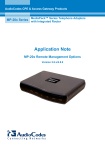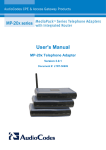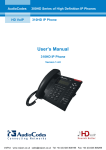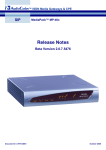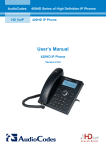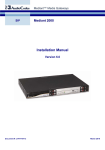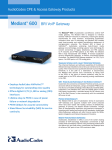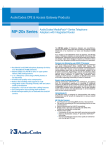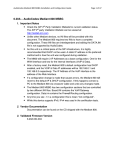Download AudioCodes MP-20x Installation guide
Transcript
AudioCodes™ MP-20x Telephone Adapter Frequently Asked Questions (FAQs) AudioCodes Customer Support Page 2 AudioCodes Customer Support Table of Contents Introduction................................................................................................................6 Frequently Asked Questions ....................................................................................7 Web Access ...................................................................................................................... 7 Q1: How must I configure my PC in order to connect to the MP-20x Web interface? .....7 Q2: Why can’t I access MP-20x Web interface when my PC is connected to the LAN? .7 Q3: Why can’t I access the MP-20x Web interface while connected to the WAN? .........8 Q4: Why can’t I ping MP-20x? ..........................................................................................8 Q5: How do I ping/trace route from MP-20x to other devices in the network?.................8 Q6: Can I use different types of Internet connections such as L2TP, PPTP, and PPPoE? .....................................................................................................................9 Default Configuration....................................................................................................... 10 Q1: How do I restore MP-20x to factory default settings?..............................................10 SIP Configurations .......................................................................................................... 11 Q1: Which SIP parameters do I have to configure for MP-20x? ....................................11 VoIP Troubleshooting ...................................................................................................... 12 Q1: How do I troubleshoot SIP calls? .............................................................................12 Q2: Why do I hear a fast busy tone after I pick up the phone (even though all SIP parameters have been configured)?........................................................................13 Q3: Why do I hear a fast busy tone when making outgoing calls (even though SIP parameters have been configured)?........................................................................14 Q4: How do I troubleshoot voice echo? .........................................................................14 Regional Settings ............................................................................................................ 15 Q1: The ring back tone and busy tone are unfamiliar. How can I adjust my call progress tone? .........................................................................................................15 Bandwidth........................................................................................................................ 16 Q1: How can I reduce bandwidth utilization for calls from MP-20x? ..............................16 Q2: How can I improve voice quality when using Emule/BitTorrent on a PC behind MP-20x? ..................................................................................................................17 Functionalities ................................................................................................................. 18 Q1: Does MP-20x support special services such as call forwarding, conference calls, and do-not-disturb?..................................................................................................18 Q2: What types of fax transport methods are supported by MP-20x? ...........................19 Q3: How do I make a three-way conference call (using Flash Hook Only)?..................20 Q4: Does MP-20x support SIP proxy redundancy? .......................................................20 Q5: Can MP-20x operate behind a NAT? ......................................................................21 Q6: What is the maximum number of phones that can be connected in parallel to a single MP-20x FXS port? .........................................................................................21 Q7: Can I set up my service so that my caller ID on outbound calls is blocked by default for all calls, without having to dial additional digits? ....................................21 Software Upgrade ........................................................................................................... 22 Q1: How do I upgrade the MP-20x software? ................................................................22 Q2: How can I automatically upgrade one or more MP-20x devices? ...........................23 Telnet and Advanced Configuration ................................................................................ 24 Q1: Can I manage MP-20x from the Telnet? .................................................................24 Q2: How can I hide the configuration file in the Web? ...................................................24 Q3: Why doesn’t MP-20x upgrade from a file in the HTTP server after it is retrieved? .25 Q4: When is the configuration file retrieved from the HTTP server? .............................25 Q5: How do I open a TR-069 license? ...........................................................................25 Page 3 AudioCodes Customer Support List of Figures Figure 1: MP-20x IP Address Pool Allocated to LAN Hosts ................................................................... 7 Figure 2: Enabling Remote Administration (WAN) in the Remote Administration Screen ..................... 8 Figure 3: Selecting Internet Connection Type in the Web Interface ...................................................... 9 Figure 4: Restoring Factory Defaults in the Restore Defaults Screen ................................................. 10 Figure 5: Restoring Defaults using Telnet ............................................................................................ 10 Figure 6: Defining Log Level using Telnet ............................................................................................ 12 Figure 7: Viewing System Logs in the Web Interface .......................................................................... 12 Figure 8: Verifying SIP User Registration in the Web Interface ........................................................... 13 Figure 9: Verifying SIP Proxy User Name and Password in the Web Interface................................... 13 Figure 10: Configuring Proxy’s Domain Name in the Web Interface ................................................... 14 Figure 11: Selecting Regional Location in the Web Interface .............................................................. 15 Figure 12: Selecting Codecs in the Web Interface ............................................................................... 16 Figure 13: Editing Traffic Shaping in the Web Interface....................................................................... 17 Figure 14: Configuring Supplementary Services in the Web Interface ................................................ 18 Figure 15: Configuring Transparent Fax Transport Method ................................................................. 19 Figure 16: Configuring T.38 Fax Transport Method ............................................................................. 19 Figure 17: Configuring Voice Band Data Fax Transport Method ......................................................... 19 Figure 18: Configuring Bypass Fax Transport Method ........................................................................ 19 Figure 19: Configuring SIP Proxy Redundancy in the Web Interface .................................................. 20 Figure 20: Configuring NAT in the Web Interface ................................................................................ 21 Figure 21: Blocking Caller ID in the Web Interface .............................................................................. 21 Figure 22: Upgrading MP-20x using the Web Interface ....................................................................... 22 Figure 23: Automatically Upgrading MP-20x using the Web Interface ................................................ 23 Figure 24: Connecting to LAN Interface using Telnet .......................................................................... 24 Figure 25: Enabling Access to MP-20x from the WAN ........................................................................ 24 Page 4 AudioCodes Customer Support Notice This document provides Frequently Asked Questions (FAQ’s) for AudioCodes MP-20x Telephone Adapter. Information contained in this document is believed to be accurate and reliable at the printing. However, due to ongoing product improvements and revisions, AudioCodes guarantee the accuracy of printed material after the Date Published nor can it responsibility for errors or omissions. Updates to this document and other documents viewed by registered customers at http://www.audiocodes.com/downloads. time of cannot accept can be © Copyright 2009 AudioCodes Ltd. All rights reserved. This document is subject to change without notice. Document #: LTRT-32301 Date Published: February-18-2009 Trademarks AC logo, Ardito, AudioCoded, AudioCodes, AudioCodes logo, CTI², CTI Squared, InTouch, IPmedia, Mediant, MediaPack, MP-MLQ, NetCoder, Netrake, Nuera, Open Solutions Network, OSN, Stretto, 3GX, TrunkPack, VoicePacketizer, VoIPerfect, What's Inside Matters, Your Gateway To VoIP, are trademarks or registered trademarks of AudioCodes Limited. All other products or trademarks are the property of their respective owners. WEEE EU Directive Pursuant to the WEEE EU Directive, electronic and electrical waste must not be disposed of with unsorted waste. Please contact your local recycling authority for disposal of this product. Customer Support Customer technical support and service are provided by AudioCodes’ Distributors, Partners, and Resellers from whom the product was purchased. For Customer support for products purchased directly from AudioCodes, contact [email protected]. Page 5 AudioCodes Customer Support Introduction This document provides answers to frequently asked questions (FAQs) about AudioCodes MP-20x analog telephone adapter. These FAQs are grouped under the following topics: Web access Default configuration Session Initiation Protocol (SIP) configuration Voice-over-IP (VoIP) troubleshooting Regional settings Bandwidth Functionalities Software upgrade Telnet/advanced configuration For further information regarding MP-20x, you can refer to the following Web URL: http://www.audiocodes.com/products/mediapack-20x. If you have any questions that are not addressed in this document, please contact AudioCodes Customer Support for further assistance. Page 6 AudioCodes Customer Support Frequently Asked Questions Web Access Q1: How must I configure my PC in order to connect to the MP-20x Web interface? A: For an explanation on configuring your PC for connection to MP-20x Web interface, refer to Section “Configuring Network Parameters” in LTRT-52702 MP-20x FXS Telephone Adapter Quick Installation Guide. Q2: Why can’t I access MP-20x Web interface when my PC is connected to the LAN? A: Access problems to MP-20x Web interface from the LAN may be caused by one of the following: Your PC is not connected to the LAN - verify that your PC is physically connected to the LAN and not to the WAN. The IP address (URL) that you enter in your Web browser is incorrect (the MP-20x default LAN IP address is 192.168.2.1). The Web interface’s login name and password are incorrect (the default login user name and password is “admin”). By default, MP-20x allocates IP addresses to the LAN (i.e., DHCP server) with the IP address range of 192.168.2.2 to 192.168.2.254. The ‘IP Address Distribution’ screen allows you define the MP-20x DHCP server IP address pool, as shown below: Figure 1: MP-20x IP Address Pool Allocated to LAN Hosts Any connected PC can behave as a DHCP client or with a static IP address within the range defined above. Two PCs cannot use the same IP address for 60 minutes or less, even if the first PC was disconnected. Each IP address within the distribution range is held for a maximum of 60 minutes if used before. Page 7 AudioCodes Customer Support Q3: Why can’t I access the MP-20x Web interface while connected to the WAN? A: By default, access to the Web interface from the WAN is disabled. ¾ To enable access from the WAN: 1. Logon to the Web interface from the LAN. 2. Access the ‘Remote Administration’ screen (Advanced menu > Remote Administration icon). 3. Under the Allow Incoming Access to the Web-Management group, select the Using Primary HTTP Port check box to enable remote connection, as shown below: Figure 2: Enabling Remote Administration (WAN) in the Remote Administration Screen Q4: Why can’t I ping MP-20x? A: By default, the parameter Allow Incoming ICMP Echo Requests is disabled (in the ‘Remote Administration’ screen - see figure Figure 2). Therefore, to successfully ping MP-20x, enable this parameter by selecting this check box. Q5: How do I ping/trace route from MP-20x to other devices in the network? A: To ping/trace from MP-20x to other devices in the network, refer to LTRT-50606 MP-20x Telephone Adapter User's Manual Ver. 2.6.2, Section 13.6, “Diagnostics”. Page 8 AudioCodes Customer Support Q6: Can I use different types of Internet connections such as L2TP, PPTP, and PPPoE? A: Yes. ¾ To change the Internet connection type: 1. Logon to the Web interface from the LAN. 2. Access the ‘Quick Setup’ screen (Quick Setup menu). 3. From the ‘Connection Type’ drop-down list, select the required Internet connection type. Figure 3: Selecting Internet Connection Type in the Web Interface Page 9 AudioCodes Customer Support Default Configuration Q1: How do I restore MP-20x to factory default settings? A: You can restore MP-20x to default settings using one of the following methods: Web interface: a) Logon to the Web interface. b) Access the ‘Restore Defaults’ screen (Advanced menu > Restore Defaults icon). c) Click OK. Figure 4: Restoring Factory Defaults in the Restore Defaults Screen Telnet: a) Telnet MP-20x from the LAN. b) At the CLI prompt, run the following command: restore_defaults Figure 5: Restoring Defaults using Telnet Hardware Reset button: The Reset button is located on the rear panel of MP-20x. a) Disconnect MP-20x from power. b) Using a sharp pointed object (such as a pin), press the button and at the same time, re-connect power to MP-20x. For additional information, refer to LTRT-50606 MP-20x Telephone Adapter User's Manual Ver. 2.6.2, Section 13.5, “Restoring Default Settings”. Page 10 AudioCodes Customer Support SIP Configurations Q1: Which SIP parameters do I have to configure for MP-20x? A: For configuring SIP parameters for MP-20x, refer to the following documents: LTRT-52702 MP-20x FXS Telephone Adapter Quick Installation Guide, Section “Configuring VoIP Parameters” LTRT-50606 MP-20x Telephone Adapter User's Manual Ver. 2.6.2, Chapter 5, “Configuring VoIP Parameters” (providing a detailed description) Page 11 AudioCodes Customer Support VoIP Troubleshooting Q1: How do I troubleshoot SIP calls? A: ¾ To troubleshoot SIP calls: 1. Telnet MP-20x from the LAN. 2. Run the following command: voip_set_log_level 1 Figure 6: Defining Log Level using Telnet 3. Logon to the Web interface. 4. Access the ‘System Monitoring’ screen (System Monitoring menu), and then select the System Log tab: Figure 7: Viewing System Logs in the Web Interface Alternatively, you can monitor the WAN connection with a network sniffer such as Wireshark. For additional information, refer to LTRT-58201 MP-20x Debugging and Diagnostic Tools Application Note Ver. 2.6.1, Sections 2.1 and 2.2, and Chapter 4 “SIP Logs”. Page 12 AudioCodes Customer Support Q2: Why do I hear a fast busy tone after I pick up the phone (even though all SIP parameters have been configured)? A: The fast busy tone heard after the phone is off-hooked may be caused by the following: The SIP user is not registered. To check if your user is registered, perform the following: a) Logon to the Web interface. b) Access the ‘System Monitoring’ screen (System Monitoring menu), and then select the Voice Over IP tab. Figure 8: Verifying SIP User Registration in the Web Interface The line’s SIP Proxy user name and password is incorrect. To check this, perform the following: a) Logon to the Web interface. b) Access the ‘Voice Over IP’ screen (Voice Over IP menu), and then select the Line Settings tab. c) Edit the required line. Figure 9: Verifying SIP Proxy User Name and Password in the Web Interface Page 13 AudioCodes Customer Support Q3: Why do I hear a fast busy tone when making outgoing calls (even though SIP parameters have been configured)? A: The fast busy tone may be caused by the Proxy server not been configured with a domain name: ¾ To configure the Proxy with a domain name: 1. Logon to the Web interface. 2. Access the ‘Voice Over IP’ screen (Voice Over IP menu), and then select the Signaling Protocol tab. 3. Under Signaling Protocol group, in the Gateway Name – User Domain field, enter the Proxy’s domain name. Figure 10: Configuring Proxy’s Domain Name in the Web Interface Q4: How do I troubleshoot voice echo? A: If you hear the echo, then the echo is caused from one of the following sources: 9 9 Your own handset: try replacing the handset with a new one. The remote party: notify this to the far-end for it to resolve this issue. If the echo is heard by the remote party, ensure that echo cancellation is activated in MP-20x: a) Logon to the Web interface. b) Access the ‘Voice Over IP’ screen (Voice Over IP menu), and then select the Voice and Fax tab. c) Under the Echo Cancellation group, select the ‘Enable Echo Cancellation’ check box. Page 14 AudioCodes Customer Support Regional Settings Q1: The ring back tone and busy tone are unfamiliar. How can I adjust my call progress tone? A: To suite your call progress tones to your geographical location, perform the following: 1. Logon to the Web interface. 2. Access the ‘Regional Settings’ screen (Advanced menu > Regional Settings icon). 3. Select your location for regional settings. Figure 11: Selecting Regional Location in the Web Interface For additional information, refer to LTRT-50606 MP-20x Telephone Adapter User's Manual Ver. 2.6.2, Section 13.8, “Regional Settings”. Page 15 AudioCodes Customer Support Bandwidth Q1: How can I reduce bandwidth utilization for calls from MP-20x? A: It is recommended to use the coder G.729 to reduce bandwidth utilization to the minimum. ¾ To select a lower bit-rate codec: 1. Logon to the Web interface. 2. Access the ‘Voice Over IP’ screen (Voice Over IP menu), and then select the Media Streaming tab. 3. Under the Codecs group, select the required codecs. Figure 12: Selecting Codecs in the Web Interface Page 16 AudioCodes Customer Support Q2: How can I improve voice quality when using Emule/BitTorrent on a PC behind MP-20x? A: You must configure MP-20x to prioritize voice packets over data packets. 1. Logon to the Web interface. 2. Open the ‘Traffic Shaping’ screen (QoS menu > Traffic Shaping tab). 3. In the Tx Bandwidth field, enter the upload speed. 4. In the Rx Bandwidth field, enter the download speed. 5. Select the ‘Enable Dynamic Traffic Shaping’ check box, and then in the Tx Bandwidth During VoIP Call field, enter the value for upload rate for data bandwidth during a voice call (original upload data rate - Codec bandwidth and header size). Figure 13: Editing Traffic Shaping in the Web Interface For additional information, refer to LTRT-50606 MP-20x Telephone Adapter User's Manual Ver. 2.6.2, Section 8.1 “Traffic Shaping”. Note: If you are still experiencing choppy or delayed audio, place your MP-20x directly behind the broadband Internet modem. Page 17 AudioCodes Customer Support Functionalities Q1: Does MP-20x support special services such as call forwarding, conference calls, and do-not-disturb? A: Yes, MP-20x supports the following supplementary services: Call waiting Call forwarding Do-not-disturb Three-way conferencing Message waiting indication (MWI) Stutter tone These services are configured in the Web interface’s ‘Services’ screen (Voice Over IP menu > Services tab). Figure 14: Configuring Supplementary Services in the Web Interface For additional information, refer to LTRT-50606 MP-20x Telephone Adapter User's Manual Ver. 2.6.2, Section 5.5, “Configuring Services Parameters”. Page 18 AudioCodes Customer Support Q2: What types of fax transport methods are supported by MP-20x? A: MP-20x supports the following fax transport types: Transparent T.38 Voice-Band Data Bypass The fax transport method is configured in the Web interface’s ‘Voice and Fax’ screen (Voice Over IP menu > Voice and Fax tab). Figure 15: Configuring Transparent Fax Transport Method Figure 16: Configuring T.38 Fax Transport Method Figure 17: Configuring Voice Band Data Fax Transport Method Figure 18: Configuring Bypass Fax Transport Method For additional information, refer to LTRT-50606 MP-20x Telephone Adapter User's Manual Ver. 2.6.2, Section 5.4, “Configuring Voice & Fax Parameters”. Page 19 AudioCodes Customer Support Q3: How do I make a three-way conference call (using Flash Hook Only)? A: ¾ To make a 3-way conference call: 1. Make a call to A, and then press the flash hook button. 2. Make a call to B, and then press the flash hook button again. Flash Hook Only is configured in the Web interface’s ‘Dialing’ screen (Voice Over IP menu > Dialing tab. Under the Key Sequence group, configure the flash hook sequence method. Q4: Does MP-20x support SIP proxy redundancy? A: Yes. ¾ To configure SIP proxy redundancy: 1. Logon to the Web interface. 2. Open the ‘Signaling Protocol’ screen (Voice Over IP menu > Signaling Protocol tab). 3. Under the SIP Proxy and Registrar group, select the ‘Use Redundant Proxy’ check box, and then configure the redundant proxy parameters. Figure 19: Configuring SIP Proxy Redundancy in the Web Interface For additional information, refer to LTRT-58301 MP-20x Redundant Proxy Application Note Ver. 2.6.2. Page 20 AudioCodes Customer Support Q5: Can MP-20x operate behind a NAT? A: Yes. It is recommended to connect the MP-20x directly to your Cable or ADSL modem. However, if this is not possible, then: If the MP-20x is located behind a router that uses Application Layer Gateway (ALG), then there is no need to make any additional modifications. If ALG is not supported by the router, then it can operate behind the NAT using an external STUN server. ¾ To configure NAT: 4. Logon to the Web interface. 5. Open the ‘Signaling Protocol’ screen (Voice Over IP menu > Signaling Protocol tab). 6. Under the NAT Traversal group, select the ‘Enable STUN’ check box. Figure 20: Configuring NAT in the Web Interface Q6: What is the maximum number of phones that can be connected in parallel to a single MP-20x FXS port? A: Up to five phones can be connected to a single MP-20x FXS port. Q7: Can I set up my service so that my caller ID on outbound calls is blocked by default for all calls, without having to dial additional digits? A: Yes. ¾ To block caller ID: 1. Logon to the Web interface. 2. Open the ‘Line Settings’ screen (Voice Over IP menu > Line Settings tab). 3. Click the Action icon corresponding to the line for which you want to block caller ID. 4. Select the ‘Block Caller ID’ check box. Figure 21: Blocking Caller ID in the Web Interface Page 21 AudioCodes Customer Support Software Upgrade Q1: How do I upgrade the MP-20x software? A: ¾ To upgrade the MP-20x software: 1. Logon to the Web interface. 2. Open the ‘MP20X Firmware Upgrade’ screen (Advanced menu > MP20X Firmware Upgrade icon). Figure 22: Upgrading MP-20x using the Web Interface 3. Click the Upgrade Now button, and then browse to the folder in which the rmt file is located. After loading the rmt file, MP-20x automatically reboots to factory defaults. Page 22 AudioCodes Customer Support Q2: How can I automatically upgrade one or more MP-20x devices? A: To automatically upgrade MP-20x, you can locate the firmware (rmt file) on an HTTP/HTTPS or FTP/TFTP server, and then define the URL of this server and the name of the rmt file, as follows: 1. Logon to the Web interface. 2. Open the ‘MP20X Firmware Upgrade’ screen (Advanced menu > MP20X Firmware Upgrade icon). Figure 23: Automatically Upgrading MP-20x using the Web Interface 3. From the Upgrade From the Internet drop-down list, select “Automatic Check for New Version and Upgrade MP20X”. MP-20x checks the URL every 24 hours (user-defined) and upgrades MP-20x only if there is a later version. The firmware file is checked according to the code in the rmt file (and not according to the rmt’s file name). For additional information, refer to LTRT-55201 MP-20x Remote Management Application Note, Section 2.2.1 “Firmware Upgrade”. Page 23 AudioCodes Customer Support Telnet and Advanced Configuration Q1: Can I manage MP-20x from the Telnet? A: Yes. The LAN interface is open by default. From the PC’s command line, run the following command: telnet <MP-20x LAN’s IP address> Figure 24: Connecting to LAN Interface using Telnet The WAN interface is closed by default. To allow access from the WAN, perform the following: a) Logon to the Web interface. b) Access the ‘Remote Administration’ screen (Advanced menu > Remote Administration icon). a) Under the Allow Incoming Access to the Telnet Server group, select the ‘Using Primary Telnet Port (23)’ check box. Figure 25: Enabling Access to MP-20x from the WAN Q2: How can I hide the configuration file in the Web? A: Run the following command: rg_conf_set /rmt_config/hide_config_file_page 1 Page 24 AudioCodes Customer Support Q3: Why doesn’t MP-20x upgrade from a file in the HTTP server after it is retrieved? A: Open the Configuration file (located on the HTTP server), and then check the version value of the command line /rmt_config/version. The file on the server must have a higher version value than the current version running on MP-20x. ¾ To view the current version in MP-20x: 1. Telnet the MP-20x. 2. At the CLI prompt, run the following command: rg_conf_print /rmt_config/version Q4: When is the configuration file retrieved from the HTTP server? A: The configuration file is automatically retrieved four times after MP-20x reboots (every two minutes), and thereafter, according to the timer of the check interval value. This interval value can be viewed by performing a Telnet to MP-20x, and then running the following command: rg_conf_print / rmt_config/check_interval For example, if check_interval= 43200sec, this means 60sec*60min*12hours = every 12 hours Q5: How do I open a TR-069 license? A: ¾ To open a TR-069 license: 1. Telnet the MP-20x. 2. At the CLI prompt, run the following command: rg_conf_set /cwmp/tr069_licensed 1 Page 25 AudioCodes Customer Support MP-20x Telephone Adapter Frequently Asked Questions www.audiocodes.com


























